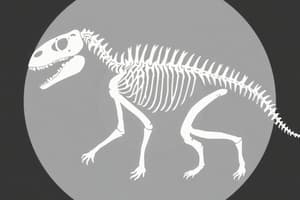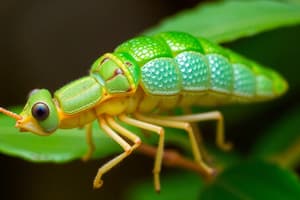Podcast
Questions and Answers
What is a main characteristic of the cell wall of Archaea?
What is a main characteristic of the cell wall of Archaea?
- It is made of peptidoglycan
- It is composed of different chemicals (correct)
- It contains cellulose
- It is similar to bacterial cell walls
Which of the following is NOT a helpful activity of bacteria?
Which of the following is NOT a helpful activity of bacteria?
- Producing vitamin K in the stomach of humans
- Digesting cellulose in the stomach of cows
- Causing tissue damage (correct)
- Decomposing organic material
Which category of Archaea includes organisms that thrive in extreme environments?
Which category of Archaea includes organisms that thrive in extreme environments?
- Non extreme archaea
- Prokaryotic cells
- Methanogens
- Extremophiles (correct)
Which of these statements about bacteria is true?
Which of these statements about bacteria is true?
What type of cell do prokaryotic organisms, such as those in the domain Archaea, lack?
What type of cell do prokaryotic organisms, such as those in the domain Archaea, lack?
What branch of biology is responsible for naming and classifying species into groups?
What branch of biology is responsible for naming and classifying species into groups?
Which of the following lists the broadest units of classification in the correct order?
Which of the following lists the broadest units of classification in the correct order?
Which domain is characterized by organisms that have a nucleus and store DNA within a membrane?
Which domain is characterized by organisms that have a nucleus and store DNA within a membrane?
What is true regarding prokaryotic organisms?
What is true regarding prokaryotic organisms?
Which of the following best describes archaea?
Which of the following best describes archaea?
What is the primary method through which methanogens obtain their energy?
What is the primary method through which methanogens obtain their energy?
Which type of archaea would be likely to thrive in extremely hot environments?
Which type of archaea would be likely to thrive in extremely hot environments?
Which of the following accurately describes a characteristic that distinguishes eukaryotes from prokaryotes?
Which of the following accurately describes a characteristic that distinguishes eukaryotes from prokaryotes?
Which of these organisms primarily live in moist or aquatic habitats?
Which of these organisms primarily live in moist or aquatic habitats?
What is a major advantage of sexual reproduction in eukaryotes?
What is a major advantage of sexual reproduction in eukaryotes?
What do halophiles specifically require for their growth?
What do halophiles specifically require for their growth?
Which group of organisms is divided into four kingdoms within the domain Eukarya?
Which group of organisms is divided into four kingdoms within the domain Eukarya?
Which of the following statements is true regarding non-extreme archaea?
Which of the following statements is true regarding non-extreme archaea?
What are the main categories under which the domain Eukarya is divided?
What are the main categories under which the domain Eukarya is divided?
Which of these characteristics is NOT typically associated with extremophiles?
Which of these characteristics is NOT typically associated with extremophiles?
Flashcards
Taxonomy
Taxonomy
The branch of biology that names and classifies species into broader groups.
Domains
Domains
The broadest units of classification in biology.
Kingdoms
Kingdoms
Large groups of organisms within a Domain, sharing certain key features.
Prokaryotes
Prokaryotes
Signup and view all the flashcards
Eukaryotes
Eukaryotes
Signup and view all the flashcards
What is the cell wall of Coli made of?
What is the cell wall of Coli made of?
Signup and view all the flashcards
What are some helpful activities of bacteria?
What are some helpful activities of bacteria?
Signup and view all the flashcards
What are some human diseases caused by bacteria?
What are some human diseases caused by bacteria?
Signup and view all the flashcards
What are Archaea?
What are Archaea?
Signup and view all the flashcards
What are the ways Archaea are grouped?
What are the ways Archaea are grouped?
Signup and view all the flashcards
Methanogens
Methanogens
Signup and view all the flashcards
Extremophiles
Extremophiles
Signup and view all the flashcards
Thermophiles
Thermophiles
Signup and view all the flashcards
Halophiles
Halophiles
Signup and view all the flashcards
Compartmentalization in Eukaryotes
Compartmentalization in Eukaryotes
Signup and view all the flashcards
Multicellularity in Eukaryotes
Multicellularity in Eukaryotes
Signup and view all the flashcards
Sexual Reproduction in Eukaryotes
Sexual Reproduction in Eukaryotes
Signup and view all the flashcards
Kingdom Protista
Kingdom Protista
Signup and view all the flashcards
Kingdom Plantae
Kingdom Plantae
Signup and view all the flashcards
Kingdom Animalia
Kingdom Animalia
Signup and view all the flashcards
Study Notes
General Biology I - 101-NYA-05
- Section: 00007/8
- Testing was conducted to see if animals "kiss"
Biology NYA Lecture 1 - Introduction to Biology
- Date: August 20th, 2024
Socrative
- Go to https://socrative.com/
- Click "student login"
- Room Name = GRIFFITHS2554
- Activity is not for marks, but for brain stimulation about Biology
Diversity of Life
- Approximately 2 million species have been identified to date; thousands more are identified annually.
- Estimates of total species range from 8-9 million.
- Taxonomy is the branch of biology that names and classifies species into groups based on increasing breadth.
- Domains, followed by kingdoms, are the broadest units of classification.
Three Domain Model
- Living things are categorized into three major groups (domains): Bacteria, Archaea, and Eukarya.
- Bacteria and Archaea are prokaryotes (lack a nucleus).
- Eukarya are eukaryotes (have a nucleus).
Domain Bacteria
- Most abundant organisms on Earth (more bacteria in your mouth than mammals on the planet).
- Found virtually everywhere.
- Some are helpful, some are harmful.
- Prokaryotic.
- Unicellular.
- Cell walls are composed of peptidoglycan.
- Most taxonomists recognize 12-15 different groups of bacteria.
- Helpful activities include decomposing organic material, degrading environmental pollutants, digesting cellulose in cows' stomachs. They can also produce vitamin K in human stomachs and make elements like nitrogen accessible to other organisms.
- Can cause diseases; attach to cells, causing tissue damage, and affect some plant diseases, and many human diseases, including syphilis, gonorrhea, chlamydia and typhoid fever.
Domain Archaea
- Prokaryotic.
- Unicellular.
- Not bacteria.
- Do not cause disease.
- Cell walls lack peptidoglycan.
- Grouped into three categories based on their environments or metabolic pathways: extremophiles, methanogens, and non-extreme archaea.
- Extremophiles thrive in extreme environments (e.g., high temperatures, high salt concentrations, extreme pH). Methanogens produce methane gas. Non-extreme archaea live in environments similar to bacteria.
Domain Eukarya
- Very diverse.
- Three characteristics distinguish them from prokaryotes: compartmentalization, membrane-bound nucleus, and differences in gene expression.
- Compartmentalization involves discrete compartments within cells.
- Eukaryotic DNA is stored within a membrane-bound nucleus.
- Eukaryotes exhibit diverse gene expression.
- Eukarya deal with environments via specialized approaches.
- Eukarya's major characteristic is sexual reproduction, which leads to genetic diversity.
Kingdom Protista
-
Diverse group of eukaryotes, mostly inhabiting moist or aquatic environments.
-
Primarily unicellular, with some that are colonial or multicellular.
-
First eukaryotes that evolved approximately 2.1 billion years ago.
-
Protista classification is in flux (some believe it should have more kingdoms).
-
Types of protists include:
- Animal-like protists: Phagotrophs, use pseudopods for movement, engulf food in vacuoles, digest food with enzymes
- Plant-like protists: Phototrophs, are autotrophs
- Fungus-like protists
Kingdom Plantae
- Multicellular eukaryotic organisms, considered autotrophs that produce their food through photosynthesis.
- Produce their own food and essential chemicals from simple substances present in the environment.
- Self-sufficient (possess their own cellular walls).
- Examples include: trees, flowers, and ferns.
Kingdom Fungi
- Includes molds and mushrooms.
- Heterotrophic; obtain energy and essential chemicals from preformed organic matter.
- Decomposers (break down dead organic matter), or in some cases are parasites (derive nutrients from living hosts.)
- Some fungi are also mutualistic (beneficial to both partners).
Kingdom Animalia
- Consists of all animals.
- Multicellular eukaryotes.
- Diverse group with varying similarities among species.
- Heterotrophic; need to obtain energy and organic building blocks from the intake and digestion of other organisms (plants or other animals).
Classification of Organisms
- Taxonomy is the science of classifying living organisms.
- A classification level is called a taxon.
- Scientific names avoid the confusion of common names.
- Organisms are classified based on shared characteristics (e.g., a dichotomous key, which employs simple yes-or-no questions).
The Binomial System
- Each organism has a unique binomial name (two-word name).
- The system uses Latin names, with the first word capitalized and the second in lowercase.
- Both words are italicized, and the first word is the genus name, while the second is the species' name.
The Linnaean Hierarchy
- An organizational scheme, where organisms are arranged into progressively larger inclusive categories, following the order of Domain, Kingdom, Phylum, Class, Order, Family, Genus, and Species.
Dichotomous Key
- A tool used to identify organisms based on a series of observable characteristics and questions.
- Questions present two mutually exclusive options for each stage leading to the identification of organisms.
Studying That Suits You
Use AI to generate personalized quizzes and flashcards to suit your learning preferences.




